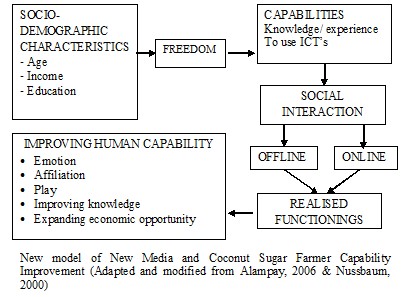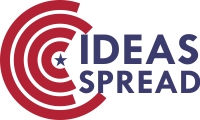New Media Access and Use for Triggering the Farmers Capability Improvement in Central Java Indonesia
Abstract
The coconut sugar industry is a hereditary business in Banyumas. However, the low income of farmers, poor education, regeneration, and limited number of extension staffs, are some of the problems associated with its development in rural areas. Therefore an alternative strategy is needed to solve these problems to stay above the competitive and fast-growing market. This study, therefore, aims to determine the access and use of the new media to trigger farmers capability improvement. In-depth interviews and FGD were used to collect data from coconut sugar farmers, extension and cooperative staff, informal leaders, and government officers. Finding show that farmers have the freedom to access new media, though the access is varied based on socio-demographic characteristics. Following their experience in online activity, farmers conduct a social interaction with related parties to discuss the information obtained. Therefore, through this interactive process, farmers tend to realize their functions to improve their capability by obtaining new information, expanding their economic opportunity, affiliation, besides play and emotion.
References
Alampay, E. A. (2006). Beyond access to ICTs: Measuring capabilities in the information society. International Journal of Education and Development using ICT, 2(3), 1-21.
Alemna, A. A., & Sam, J. (2006). Critical Issues in Information and Communication Technologies for Rural Development in Ghana. Journal Information Development, 22(4), 236-241. https://doi.org/10.1177/0266666906074181
Alkire, S. (2002). Dimensions of Human Development. World Development, 32(2), 181-205. https://doi.org/10.1016/S0305-750X(01)00109-7
Arnsperger, C., & Varoufakis, Y. (2003). Toward a Theory of Solidarity. Erkenntnis, 59(2), 157-188. https://doi.org/10.1023/A:1024630228818
Bakti, A. F. (2004). Communication and Family Planning in Islam in Indonesia. South Sulawesi Muslim Perceptions of a Global Development Program. Jakarta-Leiden: INIS.
Creswell, J. W. (2010). Research Design. Pendekatan Kualitatif, Kuantitatif, dan Mixed. Edisi Ketiga. Yogyakarta: Pustaka Pelajar.
Duncombe, R. A., & Heeks, R. B. (2002). “Enterprise Across the Digital Divide: Information System and Micro-enterprise in Botswana. Journal of International Development, 14(1), 61-74. https://doi.org/10.1002/jid.869
Ellis, F. (2000). Rural Livelihoods and Diversity in Developing Countries, Oxford: Oxford University Press.
European Commission. (2007) in Koltay, T. (2011). The media and the literacies: Media literacy, information literacy, digital literacy. Media Culture Society, 33(2), 211-221. https://doi.org/10.1177/0163443710393382
Fianagin, A. J., & Metzger, M. J. (2001). Internet use in the contemporary media environment. Human Communicastion Research, 27(1), 153-181. https://doi.org/10.1093/hcr/27.1.153
Fukuda-Par, Sakiko. (2003). The Human Development Paradigm: OperationalizingSen’s Ideas on Capabilities. Feminist Economics, 9(2-3), 301-317. https://doi.org/10.1080/1354570022000077980
Galperin, H. (2005). Wireless Networks and Rural Development: Opportunities for Latin America. Information Technologies and International Development, 2(3), 47-56. https://doi.org/10.1162/1544752054782420
Galperin, H., & Mariscal, J. (2007). Mobile Opportunities: Poverty and Mobile Telephony in Latin America and the Caribbean, DARSI (Dialogo Regional Sobre Sociedad de la Informacion).
Galperin, H., Mariscal, J., Barrantes, R. (2014). Internet and poverty: Opening the black box. IDRC Digital Library.
Gigler, B. (2004). Can ICTs empower poor communities? Towards an alternative evaluation framework based on the capability approach.Presented at the Fourth International Conference on the Capability Approach, Pavia, Italy.
Grimes, S. (1992). Exploiting information and communication technologies for rural development. Journal of Rural Studies, 8(3), 269-278. https://doi.org/10.1016/0743-0167(92)90004-P
Grimes, S. (2000). Rural areas in the information society: diminishing distance or increasing learning capacity? Journal of Rural Studies, 16(1), 13-21. https://doi.org/10.1016/S0743-0167(99)00027-3
Hickey, S., & Sarah, B. (2005). Exploring the Politics of Chronic Poverty: From Representation to a Politics of Justice? World Development, 33(6), 851-865. https://doi.org/10.1016/j.worlddev.2004.09.012
Johnstone, J. (2007). Technology as empowerment: A capability approach to computer ethics. Ethics and Information Technology, 9(1), 73-87. https://doi.org/10.1007/s10676-006-9127-x
Kleine, D., & Unwin, T. (2009). Technological Revolution, Evolution, and New Dependencies: what’s new about ict4d? Third World Quartely, 30(5), 1045-1067. https://doi.org/10.1080/01436590902959339
Kwiatkowski, L. (2005). NGOs, Power and Contradiction in Ifugao, the Philippines, Urban Anthropology & Studies of Cultural Systems & World Economic Development, 34(4), 385-436.
Littlejohn, W. S. (2002). Theories of Human Communication. Wadsworth.
Manovich, Lev. (2001). The Language of New Media. Cambridge, Mass.: The MIT Press.
Mardikanto, T. (2010). Komunikasi Pembangunan. Acuan bagi Akademisi, Praktisi, dan Peminat Komunikasi Pembangunan. Solo: Sebelas Maret University Press
Mascarenhas, O. (2010). Broadening the Agenda for ICTs for Poverty Reduction: PICTURE–Africa. Information Technologies & International Development, 6(SE), 37-44.
Miles, & Huberman. (2002). The Qualitative Research’s Companian. Sage Publishing. India. https://doi.org/10.4135/9781412986274
Mizuko, I., Heather, H., Matteo, B., Danah, B., Becky, Stephenson, H., … Lisa, T. (2009). Living and Learning with New Media: Summary of Findings from the Digital. Cambridge, Massachuset: The MIT Press.
Mulyana, D. (2000). Ilmu Komunikasi, Suatu Pengantar. Bandung: PT Remaja Rosdakarya.
Nussbaum, M. C. (1993). Non-Relative Virtues: An Aristotelian Approach. In M. Nussbaum and A. Sen (eds) The Quality of Life, 242-269. https://doi.org/10.1093/0198287976.003.0019
Nussbaum, M. C. (2000). Women and human development: The capabilities approach. Cambridge: Cambridge University Press. https://doi.org/10.1017/CBO9780511841286
Ohmer, M. L. (2007). Citizen Participation in Neighborhood Organizations and Its Relationship to Volunteers' Self- and Collective Efficacy and Sense of Community, Social Work Research, 31(2), 109-120. https://doi.org/10.1093/swr/31.2.109
Patton, M. Q. (1987). How to use qualitative methods in evaluation. Newbury Park, CA: Sage.
Perkins, D. F., Borden, L. M., Villarruel, F. A., Carlton-Hug, A., Stone, M. R., & Keith, J. G. (2007). Participation in structured youth programs: Why ethnic minority urban youth choose to participate—or not to participate. Youth & Society, 38(4), 420-442. https://doi.org/10.1177/0044118X06295051
Prastyanti, S. (2012). Mengkomunikasikan Pembangunan Pada Masyarakat Pedesaan. Acta Diurna, 8(1), 10-15.
Priyanto, D. (2010). Majalah Ilmiah Ekonomika, 13(4), 130-162.
Prosser, T. (2000). The Law and Regulators, Oxford: Clarendon Press.
Quibria, M. G., Tschang, T., & Macasaquit, M. L. R. (2002). New Information and Communication Technologies and Poverty: Some evidence from developing countries. Journal of the Asia Pacific Economy, 7(3), 285-309. https://doi.org/10.1080/1354786022000007852
Rangaswamy, N., & Nair, S. (2010). The Mobile Phone Store Ecology in a Mumbai Slum Community: Hybrid Networks for Enterprise. Information Technologies and International Development, 6(3), 51-65.
Richards, L., & Dalbey, M. (2006). Creating great places: The role of citizen participation. Journal Community Development, 37(4), 18-32. https://doi.org/10.1080/15575330609490193
Saith, R. (2001). Capabilities: The Concept and its Operationalisation. QEH Working Paper Series, 66, Queen Elizabeth House, University of Oxford.
Sen, A. K. (1983). Development: Which Way Now? Economic Journal, 93(37), 745-762. https://doi.org/10.2307/2232744
Sen, A. K. (1999). Development as Freedom, New York: Knopf Press.
Shilpa, J. (2014). A New Media Technology In Education: A Genre of Outreach Learning. Global Media Journal- Indian, 5(1), 1-10.
Shirin, M. (2000). The Internet and socio‐economic development: Exploring the interaction. Information Technology & People, 13(2), 85-101. https://doi.org/10.1108/09593840010339835
Silverstone, R. (1999). What’s new about new media?. New media and society, 1(1), 10-82. https://doi.org/10.1177/1461444899001001002
Singarimbun, M., & Penny, D. H. (1976). Penduduk dan kemiskinan; Kasus Sriharjo di Pedesaan Jawa, Jakarta: Bharata Karya Aksara.
Smith, M. L., Randy, S., & Rashid, A. T. (2011). Mobile Phones and Expanding Human Capabilities. Journal of Information Technologies and International Development, 7(3), 77-88.
Soetomo. (2006). Strategi-Strategi Pembangunan Masyarakat, Yogyakarta: Pustaka Pelajar.
Stern, M. J., & Adams, A. E. (2010). Do Rural Residents Really Use the Internet to Build Social Capital? An Empirical Investigation. American Behavioral Scientist, 53(9), 1389-1422. https://doi.org/10.1177/0002764210361692
Torri, M. C. (2009). Enhancing learning and innovation among local Communities through networks in poor rural areas: The case study of GMCL, India. International Journal of Rural Studies (IJRS), 16(1), 1-13.
Tuner, J. H. (1988). A Theory of Social Interaction. Clifornia: Stanford University Press, 11(1). Retrieved from http://www.irrodl.org/index.php/irrodl/article/view/794/1487
Vroom, V. (1964). Work and motivation. New York: Wiley.
Walters, B. B., Cadelina, A., Cardano, A., & Visitacion, E. (1999). Community history and rural development: Why some farmers participate more readily than others. Agricultural Systems, 59(2), 193-214. https://doi.org/10.1016/S0308-521X(99)00003-7
Warschauer, M. (2003). Dissecting the “Digital Divide”: A Case Study in Egypt. The Information Society, 19, 297-304. https://doi.org/10.1080/01972240309490
Wellman, B., Annabel, Q., & Witte, J. (2001). Does the Internet Increase, Decrease, or Supplement Social Capital? Social Networks, Participation, and Community Commitment. American Behavioral Scientist, 45(3), 439-455. https://doi.org/10.1177/00027640121957286
Williams, F., Strover, S., & Grant, A. E. (1994). Social aspects of new media technologies. In J. Bryant and D. Zillman (eds). Media effects: Advances in theory and research, Hillsdale, NJ: Erlbaum, 463-482.


This work is licensed under a Creative Commons Attribution 4.0 International License.
Copyright for this article is retained by the author(s), with first publication rights granted to the journal.
This is an open-access article distributed under the terms and conditions of the Creative Commons Attribution license (http://creativecommons.org/licenses/by/4.0/).









1.png)














